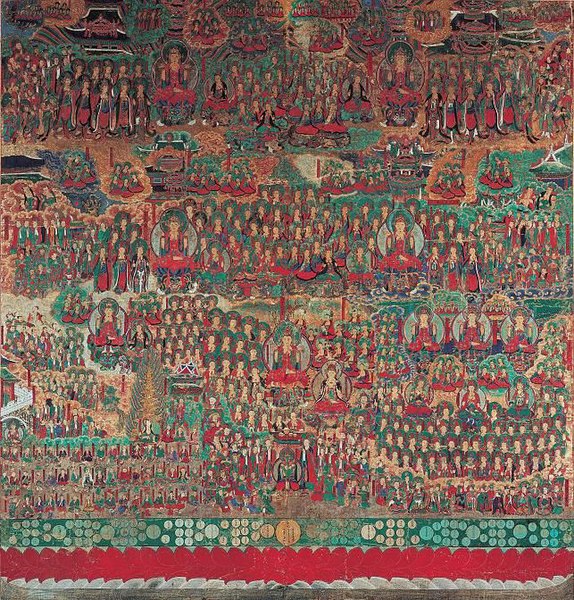The Buddhāvataṃsaka-nāma-mahāvaipulya-sūtra is one of the most influential Mahāyāna sutras of East Asian Buddhism. It is often referred to in short as the Avataṃsaka Sūtra. In Classical Sanskrit, avataṃsaka means garland, wreath, or any circular ornament, such as an earring. Thus, the title may be rendered in English as A Garland of Buddhas, Buddha Ornaments, or Buddha's Garland. In Buddhist Hybrid Sanskrit, the term avataṃsaka means "a great number," "a multitude," or "a collection." This is matched by the Tibetan title of the sutra, which is A Multitude of Buddhas.
Covers of a Korean golden pigment sutra chapter. Indigo dyed paper, with rows of golden flower blossoms, and a title cartouche, c. 1400.
Illustration of the Avatamsaka Sutra at Songgwangsa in Suncheon, Korea. Joseon dynasty, 1644.
Jin Dynasty (1115–1234) statue of Vairocana (Chinese: 大日如来; pinyin: Dàrì Rúlái), Shanhua Temple, Datong, Shanxi, China.
A Korean wooden depiction of the "three holy ones" (Vairocana Buddha, Samantabhadra and Manjushri), a triad associated with the Avatamsaka sutra, Songgwangsa temple in Suncheon.
The Mahāyāna sūtras are a broad genre of Buddhist scripture (sūtra) that are accepted as canonical and as buddhavacana in Mahāyāna Buddhism. They are largely preserved in Sanskrit manuscripts, and translations in the Tibetan Buddhist canon and Chinese Buddhist canon. Several hundred Mahāyāna sūtras survive in Sanskrit, or in Chinese and Tibetan translations. They are also sometimes called Vaipulya ("extensive") sūtras by earlier sources. The Buddhist scholar Asaṅga classified the Mahāyāna sūtras as part of the Bodhisattva Piṭaka, a collection of texts meant for bodhisattvas.
Nepalese Thangka with Prajñāpāramitā, the personification of transcendent wisdom (prajñā), holding a Mahāyāna Prajñāpāramitā Sūtra
A Tibetan depiction of Nagarjuna receiving Mahāyāna sūtras from the Nāgas (on the right)
A painting by Nicholas Roerich (1925) depicting Nāgārjuna in the realm of the Nagas, where the Prajñāpāramitā was said to have been hidden
Folio from a manuscript of the Aṣṭasāhasrikā Prajñāpāramitā Sūtra depicting Shadakshari Lokesvara, early 12th century, opaque watercolor on palm leaf








